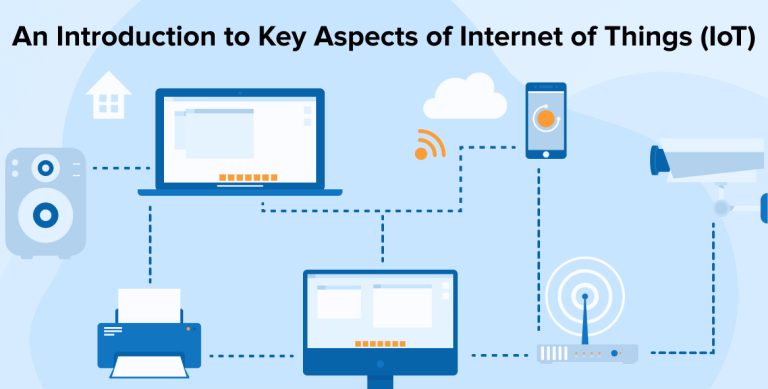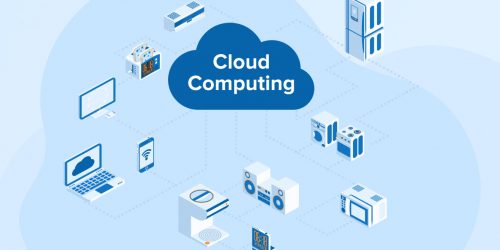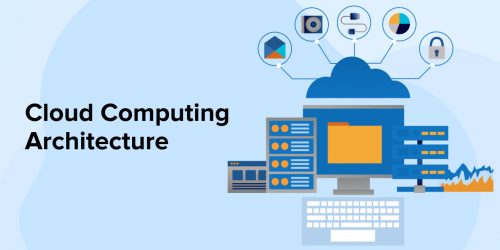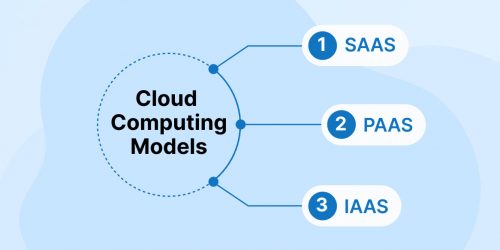Related Blogs

In this interconnected world, one of the most important technologies that have radically changed the lives of humans with the inducement of automation in all the routine tasks is IoT. Starting from Smart homes, Smart retail smart wearable, autonomous vehicles and many more. This technology has taken over the world like a storm. It is IoT technology that has changed the face of technology with smart driven automation tools and software. As the name suggests, it is an interconnection of things by the internet. Here these interconnected devices that connect different home appliances like solar panels, CCTV, laptops, security applications or any automobile object that has sensors and can collect and transmit data over the network. Without much ado, let’s dive deeper into the details of IoT custom software development.
1. Definition of Internet of Things (IoT)?
The ‘Internet of Things’ is the system of interconnected devices, machines, objects, humans, or animals that have unique IDs and the ability to share and collect data over a network without human interaction. The connection between these different objects and embedding sensors adds digital intelligence and enables them to become smart by sharing real-time data.
2. Evolution of IoT
The idea of connected devices was coined by MIT professor Kevin Ashton back in 1999 while he was working for Proctar and Gamble. Since then, the concept of IoT has been a matter of interest for every technology enthusiast for quite a long time and since then there are several inventions made regarding this.
Yet, the breakthrough of all the inventions came into existence with the idea of reinventing RFID (Radio-frequency identification) which is a wireless tracking system that uses radiofrequency waves to transfer data, into a networking technology.
Along with this, there are some of the existing technologies which have made it possible to transform a concept of IOT into practice. These are as follows:
- Low-cost low power sensors: The availability of economic/affordable sensors made it easy for manufacturers to use IoT technology.
- Network Protocols: There are many network protocols available that allow connection of sensors to the cloud and the other things for data sharing.
- Cloud Computing: In the current scenario, there are numerous cloud computing platforms available like Amazon AWS, Microsoft Azure, Google Cloud etc. which enables both consumers and businesses to access the infrastructure as required without any management overhead.
- Machine Learning: Machine learning is a programming language containing multiple algorithms that are used to extract data, analyze it and then predict future trends based on the developed data. This emerging technology has pushed boundaries for IoT.
- Artificial Intelligence (AI): Advancement in neural networks has brought digital intelligence to IoT devices. For example, digital personal assistants in mobiles like Alexa, Siri, etc.
3. The Functioning of IoT
In the IoT network, all interconnected devices have a unique IP address. They may range in complexity from a biochip transponder (think livestock) to an automobile embedded with sensors that alert the driver to several possible issues like fuel, tire pressure, needed maintenance, and more. There are IoT connected personal devices like smartwatches that measure steps taken by you in a day, your heart beats and notify you when it’s above the specified range.
So let us see how IoT functions and this can be explained in the following 3 steps:
- IoT devices collect all the data available in the devices and send them to the cloud/data centers via the internet for processing.
- Analyzing the data from a centralized repository.
- Based on that analysis, the instructions are sent to the connected devices.
At times, the cumulative time of data transmission, data processing, analyzing and then getting back to scratch is a time-consuming task. So during such critical cases, edge-computing is introduced that smartly aggregates data, analyzes it and sends it back to the initial point from where it all started. These increases turn around time by sending the information to the remote data center which is closest and thus it saves time and accelerates the process. Edge computing also boosts the overall process by allowing faster connectivity, enhanced data transferring options and further processing and storage. Let’s now consider the use case to better understand IoT as a technology.
4. Understanding IoT Using Cases Studies
The rise of IoT enabled applications has made businesses develop high-efficient and smart applications. Let’s understand the services an IoT software development company can provide. Majorly it is classified into two groups:
4.1 Industrial IoT (IIoT)
The Industrial IoT refers to the application of IoT in industrial applications, including manufacturing and energy management. Nowadays, most of the industries are shifting their focus towards the adoption of (machine-to-machine) M2M communication to achieve wireless automation and control. This change in technology with the emergence of cloud and related technologies like analytics and ML can help businesses achieve new heights in automation and can create advanced business models that boost revenue and business can invest their time in more strategic work.
4.2 Consumer IoT
This second type IOT application is consumer IoT that can connect billions of physical devices via the internet and shared which gathers information from multiple connected devices such as smartphones, smart wearables and other smart home appliances.
IoT as a technology has created wonders for most of the business and its applications are growing at a faster rate. Let’s take a look at some of the IoT use cases of the real world.
- Smart Homes and Smart Cities
How easy life would be if we can interact with home appliances and control them through voice. The appliances can automatically sense the environment and operate accordingly without any human intervention like dimming the living room lights, setting the thermostat to a cozy temperature, etc. These are some of the common use cases of this technology which are helping humans build smart homes with increased efficiency of devices and reduced costs of maintenance. The concept of inducing IoT in Smart Cities to achieve an energy-efficient and environmentally friendly infrastructure was the prime motto. These IoT devices displayed real-time information on the air quality detected by sensors across a city and predict values for the upcoming days, which will contribute towards optimizing traffic with sensor-based traffic light control and smart parking. You can read IoT based Smart City Case Study here. - Fitness Trackers, Smart Watches and other Wearables
Fitness trackers are another vital example of IoT enabled devices that measure the number of steps taken in a day by an individual. But people are looking for options where the data can be stored in their smartphones for tracking and analysis. So to meet this requirement smartwatches are available in the market which makes a seamless connection with the smartphones to track, manage, and secure their sensitive health data through advanced mobile apps. There are also some other wearable devices available such as voice-operated headphones, kids-tracker, etc. - Autonomous and Connected Vehicles: Self-driving Cars or Driverless Cars is a solid amalgamation of sensors, cameras, radar and AI in a single application. These Driverless cars are embedded with all these functionalities including ranging LIDAR that captures and stores information on road conditions, weather, driving instructions and collected data prevents potential road accidents.
- Drones: Drones or Unmanned Aerial Vehicle (UAV) has helped many businesses such as cinematographers and photographers to simplify their daily operations. Drones have helped record stunning landscapes, oil rig workers to complete full rig inspections rapidly and help e-commerce companies to deliver goods at customer doorstep. Along with this, drones are also used to help public safety units in rescue missions. Drones are also part of surveillance systems for security purposes.
- Supply Chain: IoT enabled devices are also used in the Supply chain sector to improve communication and enhance the delivery process. Without the use of IoT in the supply chain, it was getting tremendously complex and ambiguous. E-commerce companies use the supply chain process to track customer orders. The growth in customer requirements evolves and thus the products have to be procured, shipped and delivered on time with the routes coordinated accordingly. In response to this, companies are creating connected enterprise systems and using data modeling as an important part of data management strategy.
Businesses also tend to use low powered IoT devices to track products throughout the supply chain and examine the quality with essential contributing factors such as temperature, vibration and container openings, etc.
5. The Darker Side of IoT Technology
Security is the biggest concern in IoT-enabled connected devices. Devices embedded with sensors collect extremely sensitive data in many cases which are prone to get hacked due to poor security measures in IoT technology.
Researchers have discovered that around 100,000 webcams can be hacked easily because of a lack of security. For a few connected devices designed for children like Smartwatches are vulnerable to threats of getting hacked. The hackers can easily spy on conversations, track the user location and communicate with users as well. With such high risks, businesses can’t afford to implement IoT in their existing business plans. Additionally, if there is a rise in the usage of IIOT then the potential risk of getting hacked rises and the security of information is questionable. So the IoT with proper security measures will make it the most used technology in all the areas.
6. The Final Takedown
In today’s connected world where devices are more in touch than humans, the definition of staying connected is different now. We have seen how IoT as a technology innovation has transformed the way businesses work. With the introduction of IoT in most of the businesses, they feel more connected and optimized. Though there are cost concerns, connectivity issues, acceptance, and security concerns, yet the end goal seems more promising than before. With the growth in the number of connected devices, the working environment will become the start and automated by accepting flaws of security and privacy trade-offs.

Vishal Shah
Vishal Shah has an extensive understanding of multiple application development frameworks and holds an upper hand with newer trends in order to strive and thrive in the dynamic market. He has nurtured his managerial growth in both technical and business aspects and gives his expertise through his blog posts.
Related Service
Custom Software Development
Know more about our Software Development Services
Learn MoreSubscribe to our Newsletter
Signup for our newsletter and join 2700+ global business executives and technology experts to receive handpicked industry insights and latest news
Build your Team
Want to Hire Skilled Developers?





Comments
Leave a message...